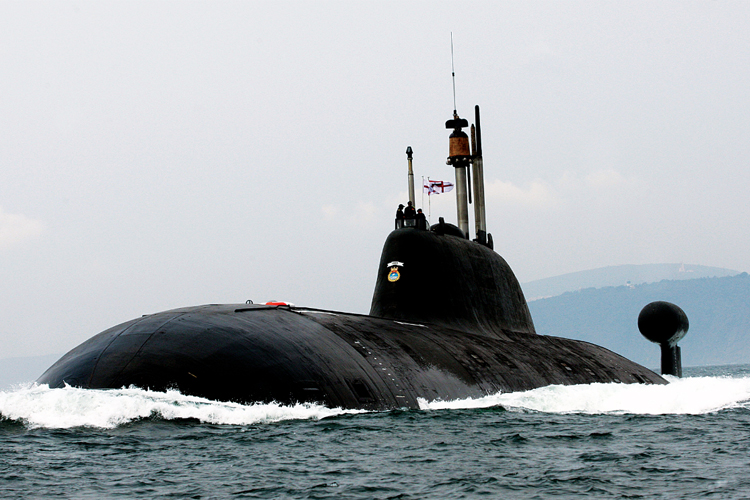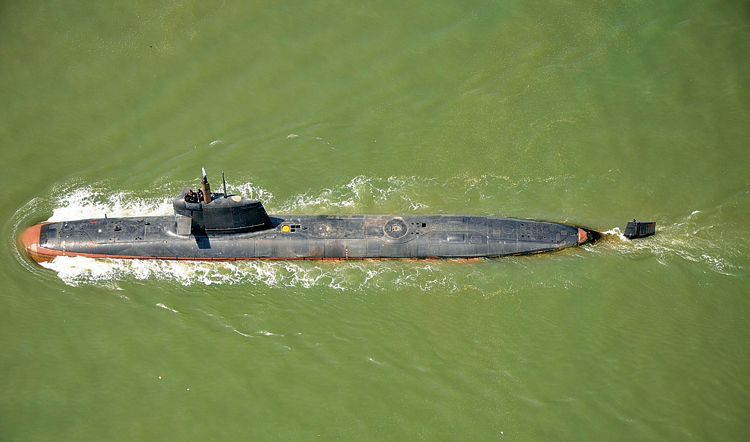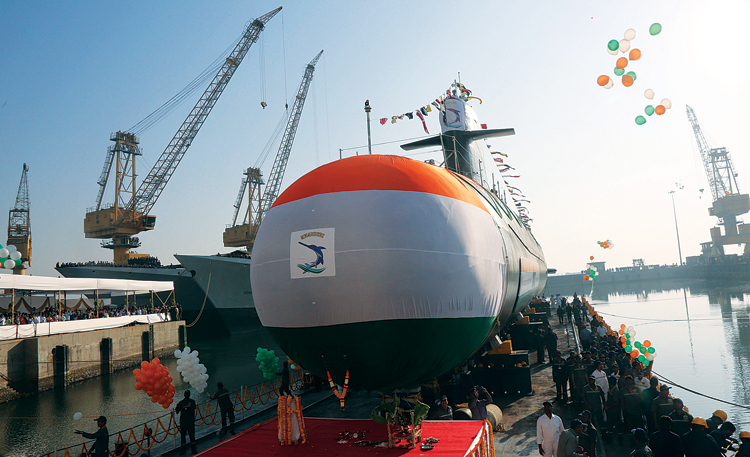INDIAN ARMED FORCES CHIEFS ON
OUR RELENTLESS AND FOCUSED PUBLISHING EFFORTS

SP Guide Publications puts forth a well compiled articulation of issues, pursuits and accomplishments of the Indian Army, over the years

I am confident that SP Guide Publications would continue to inform, inspire and influence.

My compliments to SP Guide Publications for informative and credible reportage on contemporary aerospace issues over the past six decades.
Submarine Arm Special
The Growth and Development of the Submarine Arm
The eighties was a decade of massive changes that not only recognised the importance of the submarine arm but laid the foundation for the transformation of the arm - from conventional submarine operations that would fulfil Sea Denial missions to deterrence patrols that would be the most reliable third leg of the nuclear triad

Barely three months after the Battle of Trafalgar, in January 1806 the then First Sea Lord Admiral John Jervis, Earl St. Vincent observed of submarine warfare “Pitt was the greatest fool that ever existed, to encourage a mode of war which they who commanded the seas did not want, and which, if successful, would deprive them of it.” A century and eleven years later the Zimmermann Telegram heralded the beginning of submarine warfare.
“We intend to begin unrestricted submarine warfare on the first of February. We shall endeavour in spite of this to keep the United States neutral....”
The rest as they say is history. The other milestone event that would drastically change the role of submarine was the signal made by Captain Eugene Wilkinson on January 17, 1955 “Underway on Nuclear Power”. Nuclear propulsion had completed the metamorphosis of the submersible into a true submarine, whose ability to stay submerged was limited only by human endurance. Speed, endurance and the standard weapon load of torpedoes coupled with stealth had given it the unique ability to deliver substantial firepower, operating independently.
The USS George Washington, the first SSBN was commissioned on December 30, 1959. The submarine now became capable of delivering a nuclear strike. The SSBN became the platform of choice for the “assured second strike capability”, that would ensure mutual assured destruction... a vital strategy for maintaining stability of Deterrence.

The Indian Navy commissioned its first submarine INS Kalvari; an erstwhile Soviet built F class on December 8, 1967. The historical prejudices and reluctance that stymied the induction of submarines afflicted Indian naval thinking... A navy preoccupied with ‘Sea Control’ did not think too much about submarines, especially in the early years when the Naval Budget was indeed modest.
The Beginning
Indian Submarine Arm began its journey with the commissioning of INS Kalvari followed by three more of the same class, inducted in a span of two years. The Vela Class followed. These ‘F’ class submarines laid the foundation for safe and efficient submarine operations. The Indian Navy had already started its quest for indigenisation of surface ships; INS Nilgiri was commissioned in 1972. It was only natural for the navy to seek to extend indigenous build capability to submarines. The now infamous HDW programme was initiated in 1983. The plan was to induct four submarines, two to be built at HDW and the balance two at MDL, Mumbai. There was also an option clause to build two more should it be considered expedient. This project was intended, inter-alia to provide us the opportunity to ‘Learn and Execute’ the submarine build process.
Concurrent with the initiation of the HDW programme, for some inexplicable reason the Indian Navy ordered import of four 877 EKM submarines from the erstwhile Soviet Union. The strength of the 877 EKMs was eventually increased to 10. This decision was non sequitur in the indigenisation idea. The HDW scam and the 877 EKM acquisition programme sounded the death knell for the indigenous submarine programme. All facilities created at MDL and skills that were developed fell to disuse after INS Shankul was delivered in 1994.
Changes
The Shishumar (HDW) and the Sindhughosh (877EKM) class submarine represented vastly differing design, construction and weapon system philosophies. These changes imposed great challenges in training. However, despite these constraints the crews of these submarines quickly mastered the art of safely operating and effectively exploiting them.
The induction of these submarines gave the submarine arm and the submarine design team an opportunity to observe experience and exploit submarines of different designs that no other country in the world would have had. We now had the opportunity to compare and derive valuable lessons which would have helped us in our quest for indigenisation. However, unfortunately that was not to be. Instead of objectively analysing and deriving the best, the submarine arm became polarised, mainly because either group felt that they had the compulsion to establish that the boats that they served in was the best.

After Pokhran-1 in 1974, it was natural to dabble with the idea of a nuclear submarine. Some preliminary attempts were made in the early eighties to design and demonstrate an indigenous nuclear submarine, under the aegis of the DRDO and BARC. Some officers of the design team who had been deputed to IKL Lubeck as part of the HDW programme were roped in to design the submarine. However, there were many impediments that prevented fruition of that programme. To enable us to learn and comprehend nuclear submarine operations a Charlie Class Submarine, christened INS Chakra was leased from the Soviet Union in 1987.
The eighties was a decade of massive changes that not only recognised the importance of the submarine arm but laid the foundation for the transformation of the arm - from conventional submarine operations that would fulfil Sea Denial missions to deterrence patrols that would be the most reliable third leg of the nuclear triad.
Hindsight
In the late nineties a decision to invoke the option clause of building two more submarines of the HDW programme was explored. The key stipulation was that the HDW not to be involved as a investigation was going on against them. DCNS France was to help build the submarine under licence that DCNS was to obtain from HDW!! However, the important question that needed to be answered was “Why is it that we, who had built two submarines of the same design, were unable to continue the line?”
To be able to arrive at an answer we need to look at the submarine design and build environment that exists in submarine building nations. The submarines produced in any country follow a common design philosophy which is systematically and periodically upgraded. In Germany for example, IKL (Lubeck) does the design and the submarine is constructed in a construction yard. The function of the yard is essentially hull fabrication and aggregating and integrating the various equipment, machinery and systems that are sourced from myriad sources. In this case the main motors will come from Siemens, the diesel engines from MAAN, most of the combat systems from Atlas Electronik and so on. The French, the Russians and even the Americans have similar established Small and Medium-sized Enterprises (SME) environment. To be able to successfully design and deliver a submarine there must exist an indigenous technology base and industrial capability that would be able to support the design requirements i.e. a capable SME environment.
The South Koreans started submarine construction after us. Today, they have established the design and build capability, complete with a superb SME environment. They make their own engines, motors, SONARS, torpedoes and tube launched missiles comparable to the best available in international markets. Our inability to continue with the HDW line or the failure to progress indigenous design for the nuclear submarine programme was essentially because neither the designers nor the builder had knowledge of or the access to equipment systems and weapons that would make the submarine a capable weapons platform.
R&D
The Shishumar class when it was acquired had state-of-the-art systems. The design, the equipment fit and the weapon and sensor package had a harmony that enabled facility of operation. For example, the design of the snort system permitted preparation and starting diesel engines even before the snort mast broke surface. This allowed the submarine to drastically reduce unproductive exposure. Based on some of the systems on board the DRDO undertook various R&D programmes, notable among which were the Panchyendra, which was to be an integrated combat management system and the Wire Guided Torpedo.
Taking into consideration our maritime responsibilities the Indian Navy would require a force level of six to eight SSNs for deterrent patrols, shadowing and other covert missions. We cannot continue to depend on leased SSNs to provide us this capability indefinitely.
The Panchyendra had incorporated some very innovative solutions. The CMA mathematics had some methods which were better than the Shishumar on board system. However, neither programme saw fruition for a variety of reasons. The sad part was we did not persevere. In the late nineties there was an unenthusiastic attempt at a Close Cycle Diesel based AIP. Thereafter in 2005/2006 Naval Material Research Laboratory (NMRL) was given the go ahead to work on the Phosphoric Acid Based Fuel Cell AIP. This was to be engineered for the Scorpene. However, from available reports the Scorpenes are unlikely to be fitted with any kind of AIP.

In the period from commissioning INS Shishumar to the late nineties when the Indian Navy was seeking to invoke the option clause of building two more submarines, tremendous changes in technology had already taken place. Stealth features were enhanced by cradle mounting equipment and systems. Torpedo ranges were enhanced considerably. Proton-exchange membrane (PEM) fuel cell technology had already matured. Optronic masts, towed array SONAR and towed wire antennae had revolutionised the conventional submarine capability and operating milieu. The Shishumar class underwent a midlife update with the German CSU90-14 combat suite, Ziess periscopes, etc.
The reasons why we lag in R&D needs to be studied and rectified. Prima Facie, it would seem that companies such as Thales, Atlas, Atlas Elecktronik, Sagem, Karl Ziess and corresponding establishments in Russia universalise the applications across platforms. For example optronics is used in surface ships, submarines, aircraft, tanks and even the infantry. This ability to adopt, modify and scale systems for varied applications allows them to sustain R&D and remain relevant.
The Future
Submarines have evolved as the most effective offensive weapons platform that can operate independently in any maritime area. The inherent quality of stealth firepower and survivability makes them platforms of choice for deterrent missions in the entire spectrum of conflict. In the future, as deterrence gets tested the one platform that can provide graded out of area riposte will be the SSN.
To fulfil national security and maritime security missions it behoves the Indian Navy to deploy sizeable number of SSKs, SSNs and SSBNs. The need for a healthy force level of submarines has been accepted by the government. The ongoing Project 75 and the Arihant programme indicate the government’s intent. However, decision delays and delays in delivery schedules continue to plague us. There is a need to quickly implement the P75(I) programme and begin construction of the much needed SSNs. Taking into consideration our maritime responsibilities the Indian Navy would require a force level of six to eight SSNs for deterrent patrols, shadowing and other covert missions. We cannot continue to depend on leased SSNs to provide us this capability indefinitely.
The crucial lesson that stands out is that the most effective and cost effective way to build submarines is to follow an established design and build philosophy bringing in well thought out incremental changes.
The most important aspect that provides credibility to any policy is demonstrable capability. To ensure maritime security and provide credibility to our nuclear deterrence policy we need a force level of 24 to 30 attack submarines (conventional and nuclear) and at least six SSBN that would provide the capability of delivering the credible minimum deterrence at any given time.
In the Golden Jubilee year of the Indian Navy’s Submarine Arm let us lay the foundation to establish the National Competence to build, deploy and sustain a viable submarine capability.
Conclusion
RAND Corporation study “Learning From Experience” gives valuable insights into problems associated with submarine building. The crucial lesson that stands out is that the most effective and cost effective way to build submarines is to follow an established design and build philosophy bringing in well thought out incremental changes. To be able to do this and avoid obsolescence the SME environment needs to gear-up like it has happened in Korea and China. They adopted a build philosophy, established technology thresholds and progressed.
The writer is former Inspector General, Nuclear Safety and FOC-in-C, Southern Naval Command.





